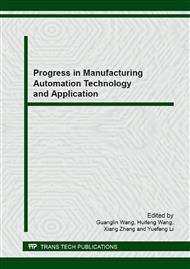[1]
B.S. Xu: Thermal Spray Technology, Vol. 2 (2010) No. 3, pp.1-6. (In Chinese).
Google Scholar
[2]
B.S. Xu, S.C. Liu, R.H. Li and J.K. Yao: China Surface Engineering, Vol. 17 (2004) No. 2, pp.1-6. (In Chinese).
Google Scholar
[3]
B. He and W.B. Lin: Machinery Design & Manufacture, (2012) No. 4, pp.279-281. (In Chinese).
Google Scholar
[4]
X.L. Zhang, X.F. Chen, B. Li and Z.J. He: Journal of Mechanical Engineering, Vol. 47 (2011) No. 11, pp.100-116. (In Chinese).
Google Scholar
[5]
B.S. Xu, S.N. Ma, S.C. Liu and W. Zhang: China Mechanical Engineering, Vol. 11 (2000) No. 1-2, pp.36-38. (In Chinese).
Google Scholar
[6]
X. Chen, Y. Jian and Z. Wang: Industrial Engineering and Management, (2004) No. 2, pp.59-61. (In Chinese).
Google Scholar
[7]
B.S. Xu, S.N. Ma, S.H. Zhu and S. Zhu: Materials Review, Vol. 1 (2002) No. 16, pp.3-6. (In Chinese).
Google Scholar
[8]
L.H. Dong, B.S. Xu, S.Y. Dong and D. Wang: The 4th World Congress on Maintenance (Haikou, China, November 24, 2008). Vol. 1, pp.565-569. (In Chinese).
Google Scholar
[9]
G.Q. Zhang, C.T. Wang and B.S. Xu: Journal of Mechanical Strength, Vol. 33 (2011) No. 3, pp.469-474. (In Chinese).
Google Scholar
[10]
M. Makkonen: International Journal of Fatigue, Vol. 25 (2003) No. 1, pp.17-26.
Google Scholar
[11]
K.Q. Xia and W.X. Yao: Journal of Mechanical Strength, Vol. 16 (1994) No. 4, pp.19-26. (In Chinese).
Google Scholar
[12]
L. Li, L.Y. Xie, X.H. He and J.F. Zhao: China Mechanical Engineering, Vol. 31 (2010) No. 3, pp.355-358. (In Chinese).
Google Scholar
[13]
J. Schijve: International Journal of Fatigue, Vol. 25 (2003) No. 8, pp.679-702.
Google Scholar
[14]
B.S. Xu: Foundations and Applications of Remanufacturing Engineering (Harbin Industrial University Press, China 2005), pp.67-68. (In Chinese).
Google Scholar
[15]
Z.T. Hu: Gear-box Axis of Automobile Fatigue Simulation and the Investigation Method for Remaining Life Predication (MS., Hefei University of Technology, China 2010), pp.22-23. (In Chinese).
Google Scholar
[16]
C.R. Meng, B.Y. Lu and Y.B. An: Journal of Agricultural Mechanization Research, (2009) No. 5, pp.86-88. (In Chinese).
Google Scholar
[17]
J.B. Ibsf and H. Agerskov: Journal of Constructional Steel Research, Vol. 37 (1996) No. 3, pp.229-261.
Google Scholar
[18]
K.C. Liu and J.A. Wang: International Journal of Fatigue, Vol. 23 (2001) No. s1, pp.129-134.
Google Scholar
[19]
W.X. Yao: Fatigue Life Prediction of Structures (National Defence Industry Press, China 2003), p.25. (In Chinese).
Google Scholar
[20]
B. Ravindra, T. S. Kumar, V. Balasubramanian: Transactions of Nonferrous Metals Society of China, Vol. 21 (2011) No. 6, pp.1210-1217.
Google Scholar
[21]
Z.J. Ren: Fatigue Analysis and Simulation of Maglev Bogie in Low and Middle Speed Maglev Train (MS., Hefei University of Technology, China 2005), pp.16-18. (In Chinese).
Google Scholar
[22]
Y.X. Li, W.X. Yao and W.D. Wen: Journal of Mechanical Strength, Vol. 24 (2002) No. 2, pp.258-261. (In Chinese).
Google Scholar
[23]
D.G. Shang, D.K. Wang and M. Li: Chinese Journal of Mechanical Engineering, Vol. 38 (2002) No. 1, pp.67-70. (In Chinese).
Google Scholar
[24]
Y. Yin, G.Y. Grondin, K.H. Obaia and A.E. Elwi: Journal of Constructional Steel Research, Vol. 1 (2008) No. 64, pp.62-71.
Google Scholar
[25]
M.M. Topac, S. Ercan and N.S. Kuralay: Engineering Failure Analysis, Vol. 20 (2012), pp.67-79.
Google Scholar
[26]
G.Q. Zhang: Study on Residual Fatigue Life Prediction Methods of Remanufacturing Parts and Assessment of Remanufacturability (Ph.D., Shanghai Jiao Tong University, China 2007), p.17. (In Chinese).
Google Scholar
[27]
Q.K. Wang, B. Han, Q. Y Wang and M.T. Zhu: Tractor & Farm Transporter, Vol. 34 (2007) No. 3, pp.76-77, 86. (In Chinese).
Google Scholar
[28]
Y. Liu: Prediction for Residual Fatigue Life of Connecting Rod and Research on its Remanufacturability(MS., Shandong University, China 2010), pp.21-22. (In Chinese).
Google Scholar
[29]
S.T. Zhang: Predication for Residual Fatigue Life of Gears of Transmission Case and Study on Remanufacturability (MS., Hefei University of Technology, China 2009), pp.24-25. (In Chinese).
Google Scholar
[30]
X.B. Lin: China Mechanical Engineering, Vol. 9 (1998) No. 11, pp.12-16. (In Chinese).
Google Scholar
[31]
J.C. Leng, M.Q. Xu and H.Y. Xing: Journal of Materials Engineering, (2010) No. 11, pp.88-93. (In Chinese).
Google Scholar
[32]
A.A. Dubov: Metal Science and Heat Treatment, Vol. 39 (1997) No. 9-10, pp.401-402.
Google Scholar
[33]
A.A. Dubov: Thermal Engineering, Vol. 50 (2003) No. 11, pp.935-938.
Google Scholar
[34]
W.G. Wang and G. Dai: Nondestructive Testing, Vol. 27 (2005) No. 8, pp.393-401. (In Chinese).
Google Scholar
[35]
J.J. Yuan, W.M. Zhang, H.G. Liu and Z.X. Wang: Transactions of Beijing Institute Technology, Vol. 26 (2006) No. 9, pp.786-788. (In Chinese).
Google Scholar
[36]
L.H. Dong, B.S. Xu, S.Y. Dong and D. Wang: China Surface Engineering, Vol. 23 (2010) No. 2, pp.106-111. (In Chinese).
Google Scholar
[37]
S.Y. Dong, B.S. Xu, L.H. Dong and D. Wang: China Surface Engineering, Vol. 19 (2006) No. 5, pp.71-75. (In Chinese).
Google Scholar
[38]
H.Y. Xing: Fatigue Damage Evaluating and Fatigue Life Predicting Based on Magnetic Memory Technology (Ph.D., Harbin Institute of Technology, China 2007), pp.94-96. (In Chinese).
Google Scholar
[39]
B.B. Jiang, C.R. Liao, J. Luo and X. Li: Nondestructive Testing, Vol. 32 (2010) No. 6, pp.467-474. (In Chinese).
Google Scholar
[40]
J. Spanner and G. Selby: Non-destructive Engineering, (2002) No. 22, pp.68-71.
Google Scholar
[41]
Y.Y. Zhang and J.K. Lian: Journal of Henan Polytechnic University, Vol. 29 (2010) No. 2, pp.283-286. (In Chinese).
Google Scholar


